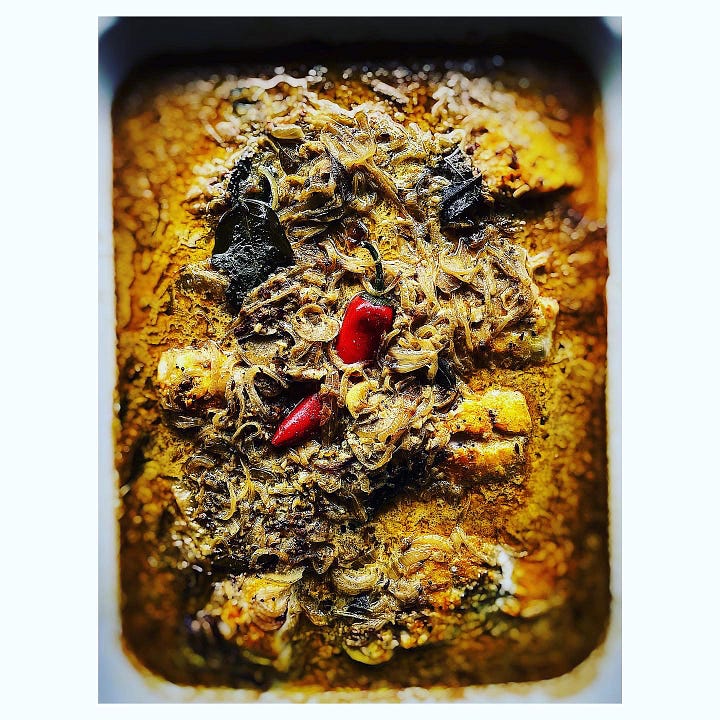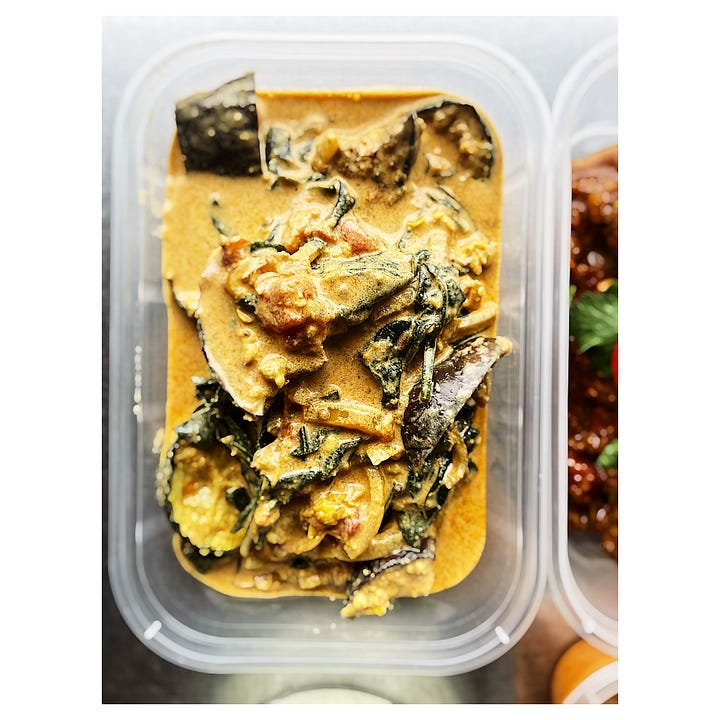Spices Part 5: Winter Spices
You don't need to cook with chilli in order to manifest warmth with spices.


Welcome to part 5 of my Spices Guide: Winter Spices - this is a meander through what I think of when I think of spices in the coldest months - please add your thoughts to the comments below.
If you are new to my Substack you can find the earlier issues of my Spice Guide by following these links: Spices Part 1: How to Store & Buy Them; Spices Part 2: How to Toast & Grind Them; Spices Part 3: Whole Spices; Spices Part 4: Spiced Salads and look out for the next edition in a couple of months - Spices Part 6: Sweet Spices.
There are many ways to warm food with spices, and for clarity I will begin here by defining what I mean by ‘warm’. I mean the full, round glow of complex flavour - like a sip of delicious red wine can ‘warm’ the palette. Think of the warming smile of a mouthful of spiced sticky toffee pudding, or a rich coconut dal heavy with cumin, curry leaves, mustard and cinnamon. This is not the warmth of chilli heat necessarily, but more the warmth created by complexity of flavour that spices can weave so brilliantly when handled well. I will take a closer look at chilli flavour and heat in a separate edition of this guide to cooking with spices.
When people tell me that they ‘don’t like spicy food’ I assume what they actually mean to say is that they don’t like food with strong chilli heat. The sentence ‘I don’t like spicy food’ to my mind refers directly to spices, of which there are so very many with such different flavour notes, how can any one person actually, honestly and meaningfully claim to like no food that is spiced? No cinnamon in an apple pie, or nutmeg on custard? No wholegrain mustard with a sausage or classic French dressing on a salad? No mulled wine or gingerbread, saffron buns or poppy seed cake? I could go on…. And I shall another time, at length! But for now we are thinking of how to use spices for a winter glow, so back to the case in hand….
I think that there are a few reasons that we associate spices with winter. Traditionally spices gained their value through the way they could be used to extend the life of food being preserved, namely meat, poultry and game. Strong aromatic spices such as cloves, allspice, cinnamon, mace and nutmeg were used in the pickling of meat to preserve it over winter, and also in the cooking of meat to mask any rancid flavour notes that may have developed over many weeks, once it came time for it to be cooked. This means that they have long been used in Europe in hearty dishes such as stews, traditionally eaten through the colder months.
This use of spices combined with their geographical distance from us and the lengthy and difficult journeys necessary to import them to the UK, made them highly valuable and prized commodities. And so they were also used for special occasions, such as religious festivals like Christmas, the mid winter festival, to flavour drinks and sweet treats - another thing that connects them to winter.
We have the Romans to thank for the process of mulling wine, they would sweeten it with honey and dates and add spices such as pepper, saffron and laurel for both their health benefits as well as flavour. It was in these ancient times that mulling low quality wine to mask poor flavour became a regular habit too. Mulled wine has been enjoyed widely throughout subsequent Empires and from what I gather it was Prince Albert and his invigoration of Christmas in this country that led to the modern day appreciation of the drink, it being popular in his native Germany before it gained popularity here. Commonly we spice our warmed wine with cinnamon, allspice, star anise, bay, orange, honey….there are many variations. When looking into classic recipes I tend to start with Felicity Cloakes ‘Perfect’ column for the Guardian, she does such an excellent job of researching many recipes, taking the reader through this process, before deciding on her own definitive version. You can find her Perfect Mulled Wine here.
I had planned to publish this Winter Spice guide before Christmas and to include some spiced biscuit recipes, but Christmas came in its annual hurricane of busy ness and sadly this didn’t happen. Instead I plan to do a sweet spices guide at Easter time, another moment where we traditionally spice our treats, and shall here focus more on the savoury delights of spices in the winter months, which brings me naturally to January and the limitations many place on their diets at this time of year…
If you are restricting your diet or limiting the variety of what you eat in any way, spices are your friend. Veganuary grows in popularity every year, with omnivores turning to a plant free diet sometimes just for January, sometimes for long beyond, but whatever the duration it can be a struggle to adjust to the restrictions inherent in following a vegan diet. Cooking with spices adds flavour where you may feel it lacking (this is not to say that a plant based diet is lacking in flavour, far from it. It is simply an acknowledgement that some find excluding things from their diet, initially at least, a loss. Adding something while simultaneously subtracting things can help with this hugely). Personally I have found flavoured salts and dukkahs really helpful to have to liven up simple eating - if you would ordinarily have crispy bacon on top of your winter ‘slaw, sprinkle some chipotle chilli salt on instead and you will have a deeply savoury and intensely tasty dish to enjoy perhaps more so than simply eating the ‘slaw on its own. Below you will find a link to my recipe for a Maple Pecan Dukkah which is delicious on porridge.
While I have turned to spices when dieting in the past, my first association with spices in winter is for warming and soothing - spices can enhance our health as well as lift our spirits, both of which can need extra support in the bleak mid winter. Hot lemon, ginger, turmeric and honey, gentle chilli in a bowl of laksa broth drenched noodles, spiced pumpkin soup, wild rice and lentils with cumin, turmeric, cinnamon - dishes like these are like a hug from the inside out. Last night we poached some prawns in a sauce rich with peanut, sesame and coconut milk, cooked with a base of onions, ginger and garlic fried with whole mustard and cumin, added to with ground coriander and turmeric, curry leaves, black pepper, a fresh green chilli - it was such a delight of winter warmth that I have shared the sauce recipe below. Spiced sauces like this finished with the addition of winter greens to wilt gently before serving help me feel full of vitamins and goodness when there is frost on the windows.
Often when I make a vegetable soup I will keep the cooking relatively plain - gently frying an onion till soft and golden with a bay leaf or two and some chopped celery if I have some, before adding some diced roots - parsnips, carrots, potatoes - sweating these for a few minutes before adding stock and cooking until the roots are cooked to my liking. Then I might add some cabbage or other greens before finishing the whole thing off with a large spoonful of whole grain mustard. I love the vinegary tang of warmth and flavour wholegrain mustard adds to vegetable soup, delicious and warming at this time of year.
Here are some quick links to recipes that I think warm well in Winter that I have already shared here on Substack:
Spiced Sides for a Sunday Roast
And below you will find my Peanut & Sesame Masala Sauce Recipe.
Happy cooking, and as always if you cook any of the recipes here, I would love to hear how you get on.
Chloe x
This sauce can be used with many ingredients - I love to poach fish and seafood in it, it is lovely with some roasted vegetables added, add some greens to wilt at the end of cooking….it really is good with pretty much everything!
Peanut & Sesame Masala Sauce
1 tablespoon smooth peanut butter
1 tablespoon tahini
1 tablespoon tamarind paste
A dash of oil - I used a tablespoon of coconut oil to cook the onion in
1 teaspoon of mustard seeds, cumin seeds
1 teaspoon of cumin seeds
1 onion, halved and thinly sliced
4 cloves of garlic, peeled and crushed
1 red chilli, deseeded and chopped
Thumb sized piece of ginger, peeled and grated
Generous pinch of curry leaves
1 piece of cassia bark, roughly 3cm long or an equivalent cinnamon quill
1 heaped teaspoon of each - ground cumin, ground coriander, ground turmeric
1 tablespoon smooth peanut butter
1 tablespoon tahini
1 tablespoon tamarind
1 tin coconut milk
1 teaspoon soft brown sugar
Juice of half a lime
Salt & pepper
Equipment
Chopping board & sharp knife
Large saucepan or wok & wooden spoon
Heat proof bowl and metal spoon
Boil your kettle and put the peanut butter, tahini and tamarind into a heat proof bowl, add 200ml of hot water from the kettle and mix together well until all the ingredients are combined. Leave to one side.
Heat the oil in the wok or pan and when hot add the mustard seeds, as soon as they start to pop add the cumin seeds, stir once and add the onions. Turn the heat down and cook for 10 minutes until starting to colour and soften. If the pan becomes dry during the cooking, add a splash of water to loosen things up
Add the ginger, garlic, chilli, cinnamon and curry leaves to the pan and stir well, cook for 2-3 minutes before adding the ground spices - again add a splash of water if the pan contents are getting dry and catching.
Next add the peanut, tahini and tamarind mixture to the pan, stir well before adding the coconut milk.
Finish with the sugar, a squeeze of lime and salt and pepper to taste.






